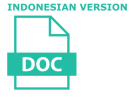Penerjemahan Makian dalam Webtoon Yakhan Yeongung ke dalam Bahasa Indonesia
Ratu Syarifa Nurazizah(1), Usmi Usmi(2*)
(1)
(2) Universitas Indonesia
(*) Corresponding Author
Abstract
Profanity is an expression used by someone for the purpose of berating, slandering, or expressing their anger towards others. In Korean, profanity also has another purpose, which is to show intimacy between the speakers and their partner. The purpose of this research is to explain how Korean profanity is translated into Indonesian in the webtoon Yakhan Yeongung. This research uses a descriptive analysis method with a qualitative approach and archival study as the research technique. This research includes Chang’s profanity classification theory as well as Vinay and Dalbernet’s translation theory as references. This research concludes that from the 28 profanity words identified in the data, 15 of them are simple profanities while the rest are compound profanities. Among those, there are two simple profanities and a compound profanity that were not translated. The translation methods used to translate these two kinds of profanity are also different. The simple profanity is translated using literal translation, transposition, equivalence and adaptation methods. Meanwhile, the compound profanity is translated using transposition, equivalence, adaptation, deletion and addition methods.
Keywords
Full Text:
PDFReferences
Baek, Y.M. (2013). An analysis of trend of verbal abusive language of university students. Korean Jurnal of Youth Studies 20(7), 1-21.
Chang, K.H. (2010). The nature and type of Korean abuses. Textlinguistics, 29(0), 401–427.
Crystal, D. (2004). The penguin encyclopedia. Penguin Books.
Dewi, H. D. & Wijaya, A. (2020). Dasar-dasar penerjemahan umum. Manggu Makmur Tanjung Lestari.
Hatim, B. & Munday, J. (2004). Translation: An advanced resource book. Routledge.
Hoed, B. H. (2006). Penerjemahan dan kebudayaan. Pustaka Jaya.
Kim, S.Y. (2002). A study on the characteristics of abuse in Korean speech and discourse analysis, 4(0), 271-290.
Ljung, M. (2011). Swearing: A cross-cultural linguistic study. http://doi.org/10.1057/9780230292376
Nirwana, A. S. A. & Usmi. (2019). Penerjemahan kata bermuatan budaya dalam novel Laskar Pelangi dan Bellitung Seomui. Proceeding of the International University Symposium on Humanities and Arts (INUSHARTS) 4.0, hal. 540-555. Universitas Indonesia.
Ni Made, P. R. (2012). “Analisis penerjemahan idiom bahasa Indonesia dalam novel Laskar Pelangi ke dalam bahasa Korea.” Tidak diterbitkan. Fakultas Ilmu Pengetahuan Budaya Universitas Indonesia.
Putri, D. M. (2018). “Pengaruh media sosial LINE Webtoon terhadap minat membaca komik pada mahasiswa Universitas Riau.” JOM FISIP, Vol. 5 No. 1. Fakultas Ilmu Sosial dan Ilmu Politik Universitas Riau.
Pyojun gug-eo daesajeon. Diakses pada 3 April 2020 melalui http://stdict.korean.go.kr
Rahman, S. (2017). “Swearing: A cross-cultural study in Asian and European languages.” Radboud University Nijmegen.
Rosidin, O. (2010). “Kajian bentuk, kategori, dan sumber makian, serta alasan penggunaan makian oleh mahasiswa.” Tidak diterbitkan. Fakultas Ilmu Pengetahuan Budaya Universitas Indonesia.
SeoPass & Kim, J. (2018). Yakhan yeongung. Naver Webtoon.
SeoPass & Kim, J. (2019). Weak hero. Diterjemahkan oleh LINE Webtoon Indonesia. LINE Indonesia
Son, J.H., et al. (2012). A qualitative study for the youth in the use of profanity. Forum for Youth Culture VOL.33, 146-172.
Sugiyono. (2013). Metode penelitian kuantitatif, kualitatif dan R&D (Ed. ke-19). Alfabeta.
Vinay, J. & Dalbernet, J. (1995). Comparative stylistics of French and English. John Benjamins Publishing Company.
Vingerhoets, A., et al. (2013). Swearing: A biopsychosocial perspective. Psychological Topics 22, hal.287-304.
Wijana, I.D.P & Rohmadi, M. (2012). Sosiolingustik: Kajian teori dan analisis. Pustaka Pelajar.
Yang, H.R. (2019). “A study on the formation of the language culture of Korean adolescents: Focus on swearing, vulgar words, adolescents’ slang and buzzwords.” The Graduate school of Education, Yonsei University.
Yi, J. S., et al. (2017). Service design for improving adolescents’ cyber language habit. Lecture Notes in Computer Science Design, User Experience, and Usability: Understanding Users and Contexts, 403–414. https://doi.org/10.1007/978-3-319-58640-3_29
Article Metrics
Refbacks
- There are currently no refbacks.
Copyright (c) 2021 The Author(s)

This work is licensed under a Creative Commons Attribution-ShareAlike 4.0 International License.







